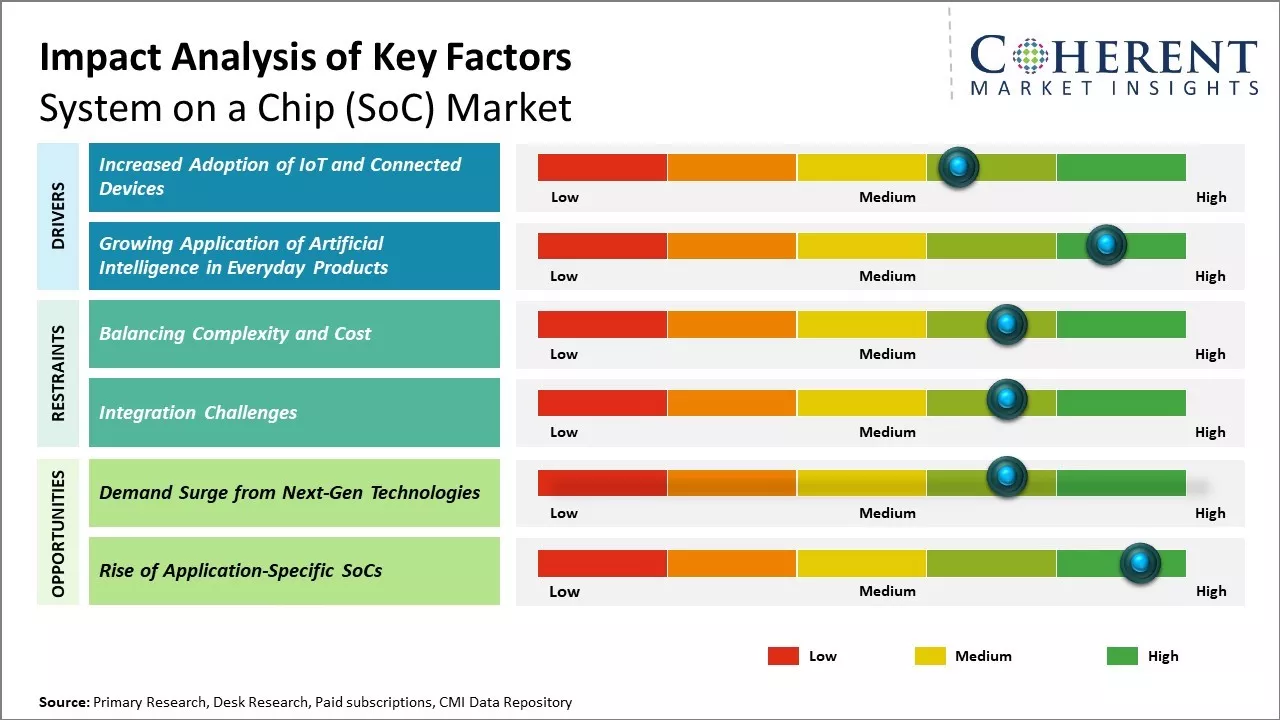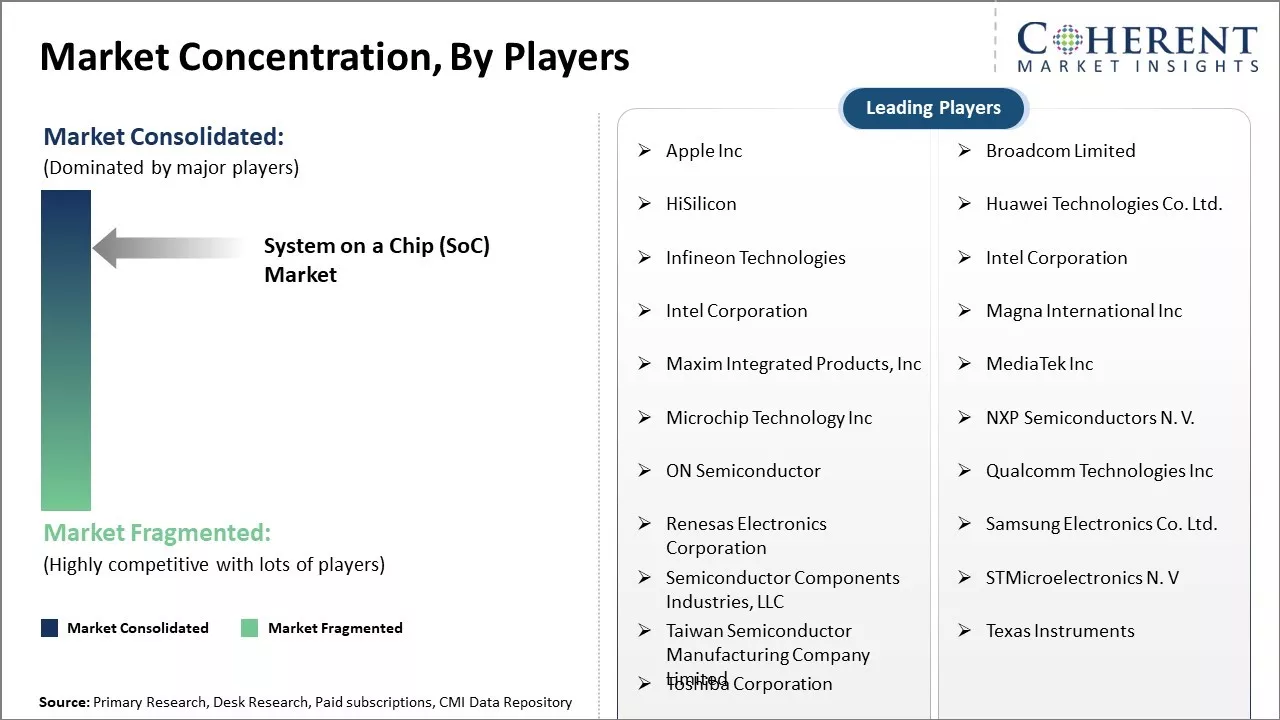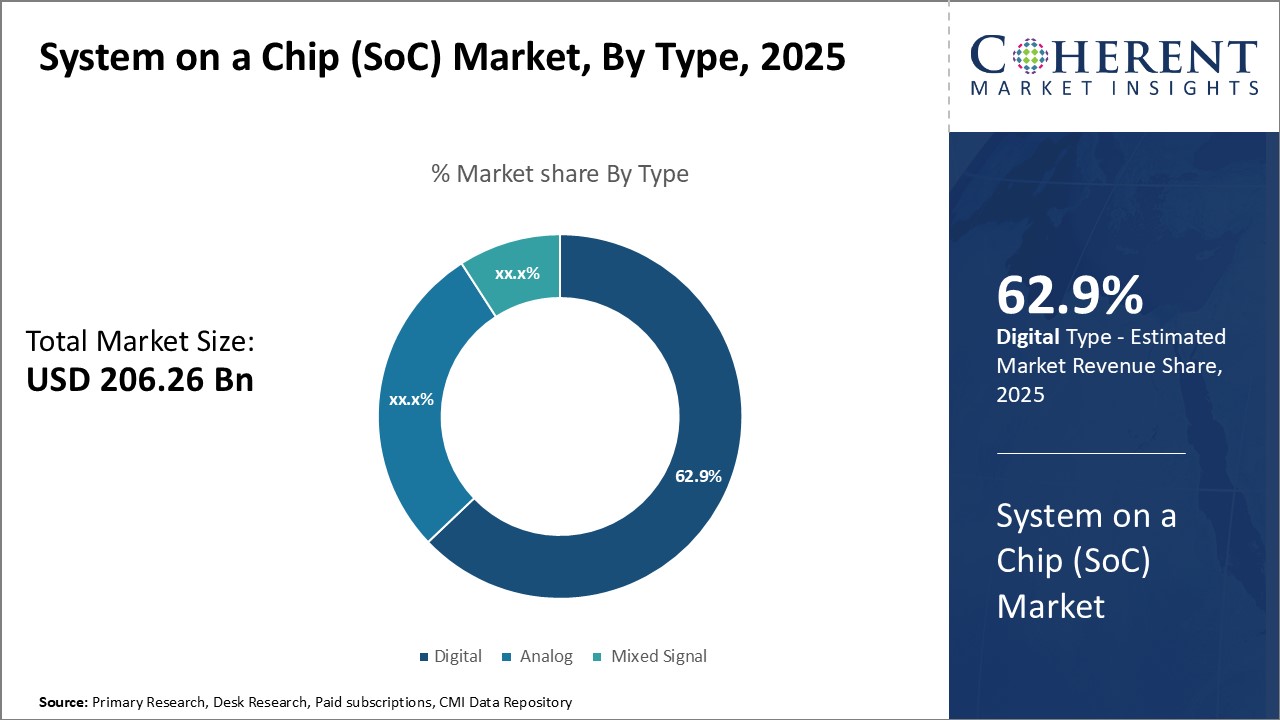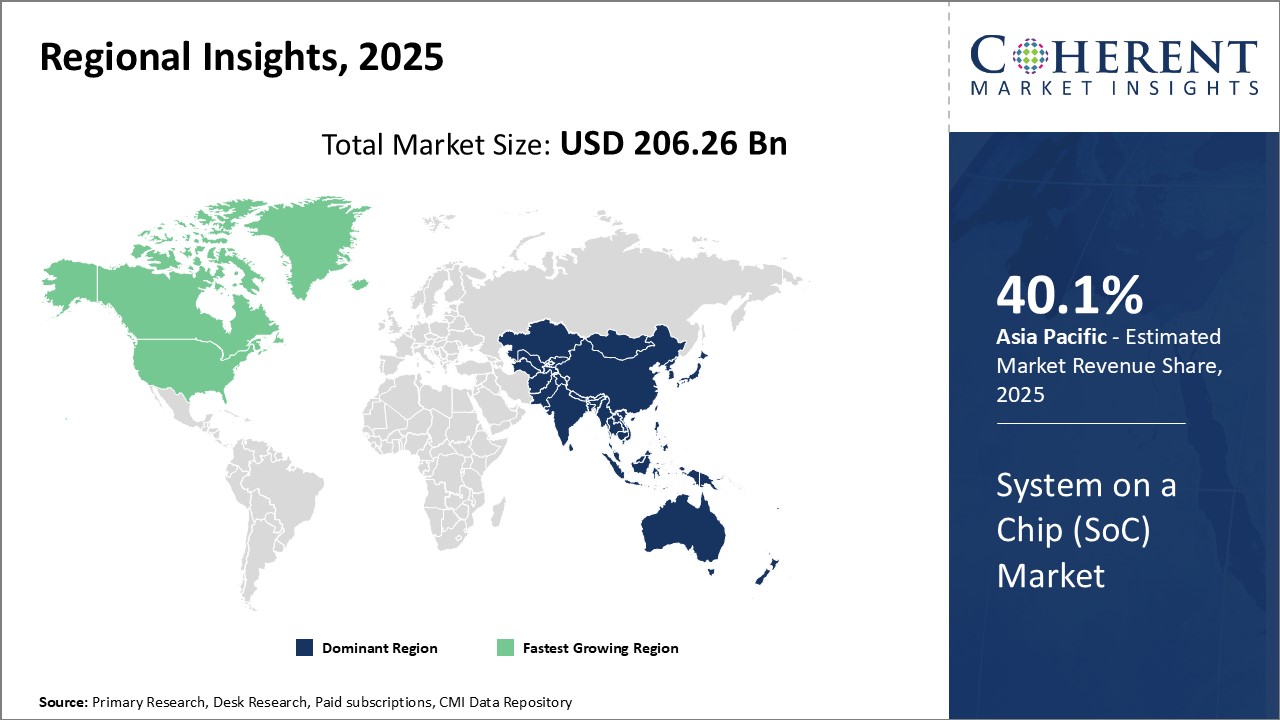Global system on a chip (SoC) Market is estimated to be valued at USD 206.26 billion in 2025 and is expected to reach USD 260.83 billion by 2032, exhibiting a compound annual growth rate (CAGR) of 3.4% from 2025 to 2032.

Discover market dynamics shaping the industry: Download Free Sample
The market is expected to witness significant growth during the forecast period. Increasing proliferation of smartphones and other consumer electronic devices boosts demand for SoCs. These chips are increasingly being incorporated across various applications due to their ability to integrate multiple components into a single unit, thus, helping minimize costs while maximizing performance. Furthermore, rising adoption of artificial intelligence (AI) and Internet of Things (IoT) powered applications is driving the market growth. However, high costs associated with developing technologically advanced SoC solutions and the ongoing chip shortage may hinder the market growth.
Increased Adoption of IoT and Connected Devices
Rising internet of things (IoT) has created new opportunities for SoC products. Almost all IoT and connected devices such as smart home appliances, wearables, industrial sensors and equipment require an SoC to process data, connect to wireless networks and perform various functions. As more devices get added to the IoT ecosystem, there is a growing need for high performance yet low power SoCs that can power these devices. Major tech companies are launching new lines of connected devices every year for applications like home automation, industrial automation, healthcare etc.
This has prompted chip makers to focus on developing specialized SoCs for different IoT segments. For instance, there is demand for low cost and low power SoCs for applications like smart sensors as well as more powerful multicore processors for industrial gateway devices. The advanced features and functionality expected from new IoT products is pushing the limits of existing SoC designs, creating opportunities for next generation solutions. With 5G networks expected to roll out in the near future, it will open new possibilities for real-time IoT applications which require extremely low latency connectivity supported by powerful and efficient SoCs. Overall the proliferation of IoT devices across different sectors boosts demand for specialized and customized SoC solutions.
OMNIVISION introduced the industry's first 3MP resolution SoC for automotive cameras in January 2022. This SoC, with the lowest power consumption and smallest size, provides a seamless upgrade path for automotive OEMs, offering high performance with a small 2.1 µm pixel size in a 1/4-inch optical format.

Get actionable strategies to beat competition: Download Free Sample
Growing Application of Artificial Intelligence in Everyday ProductsArtificial Intelligence and machine learning have developed from early experimentation phase to a powerful tools that are now enhancing various products and services. This increased adoption of AI technologies is catalyzing the SoC market as well. AI workloads require specialized hardware acceleration to run complex deep learning algorithms and models efficiently. The advanced compute capabilities expected from IoT devices is pushing the boundaries of traditional SoC designs. Edge devices performing on-device AI processing need dedicated AI processing units, neural network processors and software tools supported on high performance yet energy efficient chips.
Furthermore, developments in computer vision, speech recognition, predictive analytics and other AI technologies are finding applications in an array of fields like consumer electronics, surveillance cameras, drones, AI assistants and more. For instance, most flagship smartphones now come equipped with dedicated AI processing modules to enable superior camera and imaging capabilities. Such advanced functionalities and features demand optimized SoC platforms tailored for specific AI workloads. This growing use of AI across many industries seems poised to significantly increase the size of AI SoC market in the foreseeable future.
In January 2022, Qualcomm Technologies launched the Snapdragon Ride Vision System, a new open, scalable, and modular computer vision software stack. Built on a four-nanometer (4nm) process technology SoC, it is designed for optimized implementation in advanced driver assistance systems (ADAS) and automated driving (AD).

To learn more about this report, Download Free Sample
Market Challenges: Balancing Complexity and CostThe market faces several challenges. As device functionality increases rapidly with each new generation, designing SoCs with more complex features and capabilities within the same power and cost constraints is difficult. Growing demand for greater performance is also challenging SoC designers and manufacturers to constantly innovate while maintaining competitively low prices. Integration of multiple heterogeneous IP cores such as CPU, GPU and DSP on a single chip adds complexity.
Market Opportunities: Demand Surge from Next-Gen Technologies
Growing applications of AI, IoT, 5G, and edge computing boosts demand for advanced SoCs. Opportunities exist in developing application-specific SoCs optimized for sectors like automotive, mobile, networking, and others. Emerging technologies such as machine learning, computer vision and natural language processing need specialized SoCs.

Discover high revenue pocket segments and roadmap to it: Download Free Sample
Insights, By Type - Digital segment contributes the highest share of the market owing to evolving digital technologiesDigital segment within the market is expected to hold the largest market share of 62.9% in 2025, primarily due to rising adoption of digital technologies across most industries. Digital SoCs find widespread use in applications requiring high processing power for intensive tasks like graphics, gaming, AI, and VR/AR. The capabilities of digital SoCs allow device manufacturers to build highly advanced digital devices with powerful performance.
Growing demand for smart, connected devices that can handle real-time analytics and complex algorithms boosts need for robust digital processors. A large number of artificial intelligence and IoT applications rely on digital SoCs to support machine learning models. The capabilities of digital SoCs to power edge and cloud computing are also expanding their role in data centers and networking equipment.
Furthermore, the rapid evolution of digital technologies like 5G, big data, blockchain and more are providing a fillip to digital SoC usage. Current technology trends focus on digitization, virtualization, and making products smarter. Digital System on Chips (SoCs) are well-suited for handling the digital workloads associated with these trends. Their programmable nature allows them to easily adapt to the requirements of fast-paced digital environments.. The ability of digital SoCs to facilitate next-gen experiences through high-speed data processing will continue bolstering their share in the SoC market.
Insights, By End-use Industry - Consumer Electronics segment contributes the highest share owing to ubiquitous usage across diverse devices
Consumer electronics segment is expected to hold the largest market share of 42.28% in 2025, owing to its ubiquitous usage in a wide variety of devices. SoCs play a vital role in powering the high-performance computing, graphics, communications and other requirements of consumer devices.
These are extensively deployed in consumer gadgets like smartphones, tablets, laptops, smart wearables, smart home devices, gaming consoles and others. These devices rely majorly on application processors and other specialized SoCs for functionality. The phenomenal growth of the mobile devices industry alone has significantly boosted SoC demand from the consumer electronics sector over the years.
Current technology trends focus on digitization, virtualization, and making products smarter. Digital System-on-Chips (SoCs) are well-suited to handle the digital work required in these trends. Their programmable nature allows them to easily adapt to the rapidly changing needs of digital environments. In simpler terms, these chips are flexible and can efficiently manage the tasks involved in making things digital, virtual, and smart.
Their ubiquitous presence across diverse booming consumer categories cements the leadership of this segment in the SoC market. Continuous innovation and wider connectivity in smart home and wearable domains will likely sustain consumer electronics as a key end user of SoCs.

Need a Different Region or Segment? Download Free Sample
Asia Pacific region is expected to dominate the market with largest share of 40.1% in 2025, especially due to China, as the country is emerging as the fastest growing market for SoCs globally. Presence of a mammoth domestic market as well as aspirations of the Chinese government to develop self-reliant semiconductor industry have driven this momentum. Led by initiatives like Made in China 2025, companies like Shenzhen-based HiSilicon (Huawei) have invested heavily in developing homegrown ARM-based SoC designs for smartphones, servers and networking gear. This helps to address the geopolitical risks of relying extensively on foreign core chip supplies and technology. Meanwhile, contract manufacturers like TSMC have also expanded significantly to meet burgeoning demand from Asian clients. Growing 5G deployments, capabilities in AI/ML workloads, and smart city/IoT projects are likely to further catalyze the Asia Pacific SoC business.
North American region is expected to emerge as a fastest growing region with 11.87% CAGR in 2025, owing to presence of major semiconductor companies and consumers. The U.S. has headquarters of tech giants like Intel, AMD, Qualcomm, Nvidia, and others who have been developing their own SoC solutions and supplying to a wide customer base in assets like computers, servers, networking equipment, and consumer electronics. This early R&D focus and vertically integrated model allowed these companies to gain significant technical expertise over time. Strong demand from domestic OEMs and consumers have encouraged continuous product innovations. The region is also an leader in cutting-edge AI and 5G applications which employ advanced SoCs.
The European region has also developed considerable SoC design capabilities over the years led by companies in U.K., Germany, France, Sweden and Finland. Chips produced locally are finding applications across automotive, industrial, defense and communications industries. However, on the manufacturing front, Europe is still lagging and major fabs are located in Asia or USA. Overall, while domestic demand and capabilities have grown, geopolitical tensions and IP disputes continue to impact transatlantic trade flows of certain semiconductors and related technologies between Europe and Asia.
System On A Chip (SoC) Market Report Coverage
| Report Coverage | Details | ||
|---|---|---|---|
| Base Year: | 2024 | Market Size in 2025: | USD 206.26 Bn |
| Historical Data for: | 2020 To 2024 | Forecast Period: | 2025 To 2032 |
| Forecast Period 2025 to 2032 CAGR: | 3.4% | 2032 Value Projection: | USD 260.83 Bn |
| Geographies covered: |
|
||
| Segments covered: |
|
||
| Companies covered: |
Apple Inc, Broadcom Limited, HiSilicon , Huawei Technologies Co. Ltd., Infineon Technologies , Intel Corporation, , Magna International Inc, Maxim Integrated Products, Inc, MediaTek Inc, Microchip Technology Inc, NXP Semiconductors N. V., ON Semiconductor , Qualcomm Technologies Inc, Renesas Electronics Corporation, Samsung Electronics Co. Ltd., Semiconductor Components Industries, LLC , STMicroelectronics N. V, Taiwan Semiconductor Manufacturing Company Limited, Texas Instruments , Toshiba Corporation |
||
| Growth Drivers: |
|
||
| Restraints & Challenges: |
|
||
Uncover macros and micros vetted on 75+ parameters: Get instant access to report
*Definition: System on a Chip (SoC) Market refers to the market for integrated circuits that integrate all components of an electronic system into a single chip. SoCs include a microprocessor core, memory blocks, timing sources, peripheral interfaces and other features depending on their target application. Popular SoCs are used in smartphones, tablets, computers, networking hardware, solid-state drives and other embedded systems where sizable chip real estate and reduced power consumption are important factors.
Share
Share
About Author
As an accomplished Senior Consultant with 7+ years of experience, Pooja Tayade has a proven track record in devising and implementing data and strategy consulting across various industries. She specializes in market research, competitive analysis, primary insights, and market estimation. She excels in strategic advisory, delivering data-driven insights to help clients navigate market complexities, optimize entry strategies, and achieve sustainable growth.
Missing comfort of reading report in your local language? Find your preferred language :
Transform your Strategy with Exclusive Trending Reports :
Frequently Asked Questions
Joining thousands of companies around the world committed to making the Excellent Business Solutions.
View All Our Clients